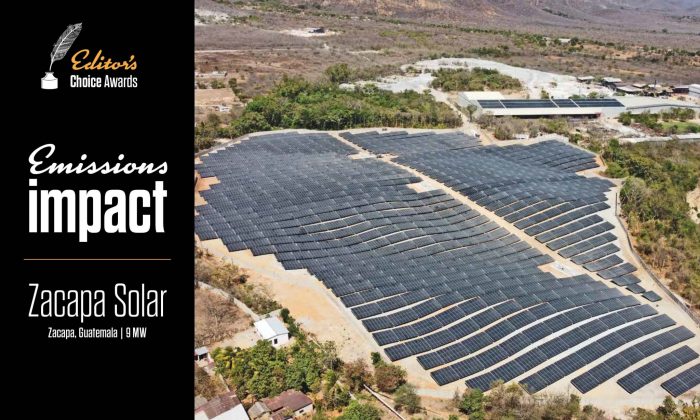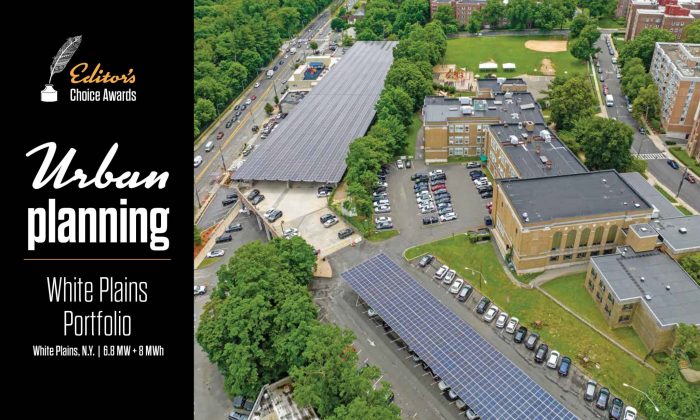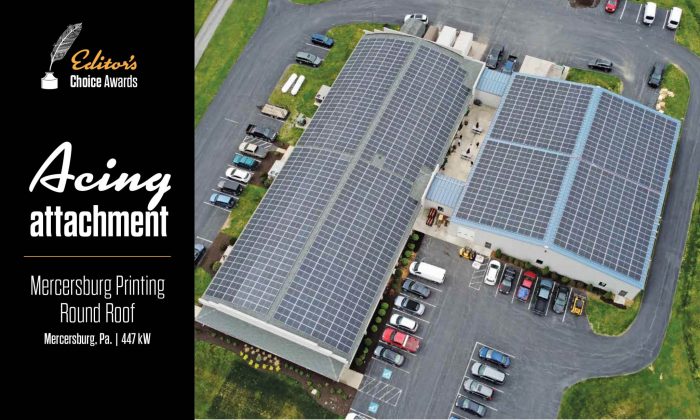We already wrote glowingly about each our Project of the Year Award winners, but as we end 2022, I wanted to highlight a few key takeaways that resonate beyond award season and will shape the solar year(s) to come.
1. Let’s focus on what solar can do instead of what it can’t
People in power need to focus less on what solar can’t do, like generate energy in darkness, and broaden their understanding of all the ancillary benefits that result from what solar power can do … like generate a steady, resilient, renewable power supply! Surely, there is a way to invest in and design solar projects that provide more benefits to a surrounding community than a system reliant on the supply, demand, pricing and long-term outlook (and health damages) of oil and gas and coal.
Before it could earn the funding to pursue the Shungnak Community Microgrid — the eventual 2022 Microgrid Project of the Year — the Northwest Arctic Borough had to prove to government agencies that “solar worked in Alaska,” given the near constant darkness for approximately two months of the year.
Not only does solar “work,” the Shungnak microgrid, in just its first year, is sporting a cost savings from its ‘diesel-off’ design in the range of $125,000 to $135,000 for the year. What’s more, the village is its own independent power producer (IPP) that is set up to reinvest all of the cost savings afforded by this initial solar + storage microgrid right back into more renewable energy projects in order to shut off its diesel generators for good. This is just the start of a circular, renewable energy economy.
So, yes, solar works in Alaska. And everywhere else that has a sun in the sky. Like, say, disenfranchised communities in the desert.
Our Residential Solar Project of the Year was a charitable project spurred on by Empowered by Light and delivered and backed by Sunnova. Yes, it is just an 18 kW solar array with a 36 kWh battery, but it provides no-cost, resilient electricity to a place and people in desperate need, and over time it could prove to be the start of another circular economy.
“There will be an added cost because of the distance, but we hope over time we’ll be able to install a lot of these systems in the Navajo Nation, and then that will make them easier to service and maybe we even employ some Navajo people to help service them,” says John Gingrich, VP of business development with Sunnova, noting they have a goal of solarizing 10 to 20 more chapter houses. “There are a couple hundred chapter houses, so this is just scratching the surface, but if we can raise a little more awareness, we can lower the skepticism and open up the interest in solar for other businesses and residences throughout the community.”
“Our community relies on the essential services provided at the Chapter House because we live in a very remote area,” says Jay Begay, Hard Rock Chapter House President, Navajo Nation. “The Chapter’s goal is to continuously develop these services, and with the extra bill savings from our new solar + storage system, we aim to do just that — expand and better our resources for the people we serve.”
The benefits aren’t limited to small communities. If we look over to Guatemala, the Zacapa Solar project won an Editor’s Choice Award for Emissions Impact because roughly 40% of Guatemala’s electricity comes from fossil fuel-based generating plants. This 9 MW system is the largest behind-the-meter distributed solar generation project in Guatemala and will provide power to a paper manufacturing business at a predetermined cost for the next 35 years — an impressive commitment for one commercial customer.

At this point, not seeing the value of investing in solar power is only a failure of imagination or will. Don’t @ me.
2. In C&I, it pays to have a diverse set of skills
Rooftop solar projects, in a vacuum, make the most sense — they are installed right atop a load center, require no additional land and have easier paths to interconnection / are often sited nearest to city load centers. But outside that vacuum, here in reality, are all of the challenges rooftops of various ages, shapes and materials present, and then all of the added costs involved in resolving those issues.
Stronghold Engineering Inc., the EPC in charge of our C&I Rooftop Project of the Year for 2022, is able to handle all of these challenges in house. Solar is actually the smallest (but growing) division of the company. Any issue that emerges beyond the scope of a PV install, SEI can readily handle.
“What’s really great is we all team together, so we get on a job and we pretty much have it covered,” says Kevin Goetz, solar manager at Stronghold. “Trenching? Not a problem. Masonry work, and so on. It all goes seamlessly.”
Integrating solar design and installation crews with other engineering and building trades under one roof is just a smart way to go. You can handle a diverse array of jobs, avoid having all of your eggs in one basket, and are just generally prepared to grow as solar becomes less of a niche and more of an everyday piece of equipment, no different than an HVAC.
Other examples:

Over in White Plains, N.Y., the White Plains Portfolio won an Editor’s Choice Award for Urban Planning because developer DSD worked closely with the city throughout the entire design and development process to navigate obstacles such as re-routing parking, periodic road closures, material storage restrictions, etc. In fact, several infrastructure improvements were incorporated into the portfolio that helped the city avoid significant capital spending.

The Mercersburg Printing Round Roof project won an Editor’s Choice Award for Acing Attachment for, well, attaching panels to a round roof. During installation, the crew used string lines, levels and a little bit of creative spacing to help blend the flatness of the modules along the curved contour of the roof to yield an aesthetically pleasing final product.
3. Batteries protect and enhance power purchase agreements
The upfront costs a large-scale energy storage system might not work for all projects yet, but the long-term benefits need to be given more consideration, especially in solar projects tied to PPAs. Our C&I Ground-Mount Project of the Year in 2022 — a 3.8 MW solar array at a juvenile justice center in Fresno, Calif. — was a no-brainer PPA deal for the county as is because it is projected to save the county $17 million to $20 million over 20 years.
But Brian Taylor, who was the director of the public sector for ForeFront Power, explained that they would soon be adding a battery, which offers a variety of extra benefits.
“A battery on site really enables a facility to handle future unknowns,” Taylor says. “Yes, we know the rate tariffs now, but in the future if they change the TOU structure again, having that battery being able to respond to that and sculpt your load accordingly is helpful. It also provides societal benefits. When you have a mass heat wave and utilities are asking for folks to curtail load, having this battery on the grid to prevent the JJC from drawing as much energy means the grid has a less spiky profile and the utility is better able to meet demand.”
As the controversial NEM 3.0 decision in California reminds us (and this change with Georgia Power), building more certainty and/or flexibility along with a solar project at the outset is only going to become more crucial and valuable as time goes on.
4. Policymakers and public utilities need to lead the way
Solar power does not need supportive policies to prove its worth or benefits. But initiating a complete reworking of our energy status quo to meet aggressive carbon reduction goals does require new state policy and a pushback against long-standing political alliances and entrenched business interests.
Our Utility-Scale Solar Project of the Year in 2022 showed how quickly even the largest solar + storage projects can come together — even in the face of crazy supply chain issues — if the state and local utilities are motivated to make it happen.
The Mililani Solar I plant was urgently needed to help replace power provided by a 180 MW coal plant (the last such plant on Oahu), which Hawaiian Electric was decommissioning in September. Clearway Energy Group and Moss somehow delivered it a full month ahead of schedule.
“The first key decision point was when the Hawaii Public Utilities Commission and the Hawaii State Energy office called on industry and Hawaiian Electric and stakeholders to propose solutions to this impending reliability crunch on Oahu,” says Nicola Park, origination manager with Clearway Energy Group, of the special circumstances. “And at that point, Clearway, in partnership with Moss and our suppliers, really dug deep on the analysis on ways to accelerate the project schedule.”
Mililani Solar I is only about a quarter of the capacity of the retired coal plant, of course, however …
“It offers a lot of great benefits and services in terms of flexibility to respond to the grid that the coal plant wasn’t capable of providing,” Park notes, “as well as shifting daytime production of solar into the evening, not to mention all the environmental health benefits due to improved air quality from not burning coal.”
And there is a reason our Community Solar Project of the Year was based in New Jersey. The state’s community solar program stands out for how its rules are crafted to maximize specific virtues that solar power can provide and incentivizing stakeholders to pursue projects that benefit the most number of people.
Extra Space Storage already had a history installing PV, so the incentives that encourage the commercial real estate sector to install more PV panels than a project would need in order to double as a community solar project, made Solar Landscape’s pitch a no-brainer.
“It comes down to program design,” says says Shaun Keegan, CEO of Solar Landscape. “It is cheaper to put solar in a field than on a rooftop, but it’s better for the grid to have it sited where the people are. And with the LMI requirements in New Jersey, you’re seeing other states follow … California, New York, Illinois, Minnesota, New Mexico, Maryland … these programs are all coming up with some sort of LMI carveout. Plus, with the LMI adder in the IRA, we think the trend will continue.”
Over in Cicero, N.Y., The Non-Wires Alternative project for National Grid won an Editor’s Choice Award for Grid Service because it is the first known project to use solar energy to charge the batteries that provide the NWA. This solution serves as an innovative, trailblazing model for how utilities can leverage solar + storage to forego typical upgrades, improve grid reliability and reduce dependence on gas-fired peaker plants.
Tags: Projects of the Year



